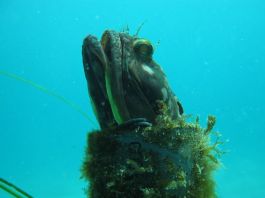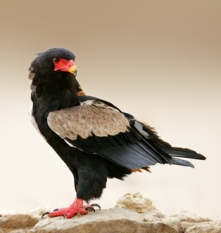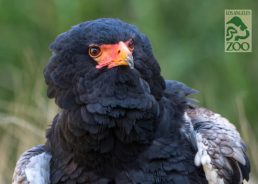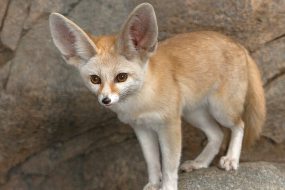Taxonomy:

- Kingdom: Animalia
- Phylum: Chordata
- Class: Actinopterygii
- Order: Perciformes
- Family: Chaenopsidae
- Genuss: Neoclinus
- Species: blanchardi
- Average Body Length: 3-8 in (7.6-29 cm)
- Lifespan: 6 years
Although usually less than 10 inches long, sarcastic fringeheads are fearless and extremely aggressive, charging at anything that approaches their burrows. The sarcastic part of their common name is attributed to their temperament and the fringehead to the distinctive appendages over their eyes.
They can be found along the Pacific coast from San Francisco Bay to central Baja California, Mexico on sand or hard mud bottoms and depths of 10 to 240 ft (3 to 73 m). It will use anything it can fit in for shelter such as empty clam, snail shells, abandoned burrows, and cracks in clay or rock outcropping. Whatever the shelter used, a sarcastic fringehead claims it as its home territory, fiercely defending it against intruders. The larger the container, the larger the fringehead occupying it.
Physical Appearance:
Sarcastic fringeheads is elongate, slender, and moderately compressed. The long dorsal fin extends from the rear of the head almost to the rounded caudal fin, a characteristic of the clinid family. Their color is typically brown to gray, often with a red tinge and green or pale blotches.
 Fringeheads are specifically known for their extremely large mouths. This is due, in part, to their characteristically long maxillary that extends nearly to the back edge of the gill cover.
Fringeheads are specifically known for their extremely large mouths. This is due, in part, to their characteristically long maxillary that extends nearly to the back edge of the gill cover.
Heads are very large, with bluntly rounded snouts and prominent lips. The huge jaw extends back well past the eye and is larger in males than females. These fish have numerous needle-like teeth and wavy, fringe-like appendages called cirri, probably used to help it ensnare slippery, moving prey.
Males can be almost black with the rear of their giant jaw a bright yellow. Usually there are pale spots or patches on the cheeks.
The dorsal spines possess two ocelli (eye-like spots), one between the first and second spines, and the other between the fifth and ninth spines. These ocelli are generally a metallic blue and outlined by a yellow golden ring
Diet:
Fringeheads are ambush predators, jumping out from their shelter to surprise prey swimming. However, what they eat in the wild is not well known. Closely related fish to the sarcastic fringehead such as pike-blennies, tubeblennies, and flagblennies are known to feed primarily on crustaceans and very small planktonic prey.
It is likely that sarcastic fringeheads eat a variety of prey. During squid spawning season, sarcastic fringeheads can be observed eating large numbers of squid eggs, a valuable food source for many species. But scientists expect that the grossly oversized mouths of the males may negatively affect their ability to feed.
Behavior:
Sarcastic fringeheads are extremely temperamental. They are fiercely territorial creatures that aggressively protect their homes from all intruders, regardless of size. The majority of the time, sarcastic fringeheads rest in their homes with only their heads protruding. However, upon the first sign of danger, they will employ their enormous mouths and needlelike teeth for defense. Initially, they emit only a warning accomplished by the flexing and snapping of their jaws. If the intruder ignores the warning, they will use their ferocious teeth to attack.

Despite their small size, their swimming movements are rather complex. Many combinations of fin manipulations are used in their frequently erratic movements. Their dorsal and anal fins are long and unbroken and are used together with their pectoral and caudal fins for swimming. Most swimming consists of short, rapid, darting movements, frequently involving quick changes in direction. Long periods of sustained swimming are not part of this species usual movement pattern.
Spawning usually occurs from January to August. A female will deposit about 3,000 eggs in a male’s shelter and swim awhile while the male guards the eggs from potential predators and other threats until this hatch. Upon hatching, larvae are about 3.0 mm or 0.12 inches long.
This sexual selection by females drives a system of intense male competition and territoriality. Male sarcastic fringeheads display to each other by opening their very large mouths in the direction of their rivals. The mouth’s intimidating coloration, combined with the extreme nature of it size (which may be as much as four times its closed size) allow the larger male to establish dominance over the smaller. Oftentimes, the rivals’ mouths are thrust very near to each other, sometimes touching. The smaller individual typically surrenders and leaves the area, without the pair actually fighting.
Conservation and Threats:

There are no known major threats to this species as it is unlikely that anyone intentionally fishes for this tiny, pugnacious fish. Sometimes accidentally caught, sport and commercial fishers are usually not comfortable handling the fish because there is a good chance of being bitten by the needle-sharp teeth of an angry fringehead unwilling to let go. Divers have reported damage to their wet suits by these grumpy little fish.
Because it occurs in deep water where threats are typically not severe, scientists believe that it not currently at risk of extinction. The species is listed as ‘of least concern’ by the IUCN Red List.
Interesting Facts:
- The ocean bottom in Redondo Canyon in southern California is littered with discarded bottles, jars, cans, and similar containers. Divers have observed that many of these littering items house a sarcastic fringehead.
- Sarcastic fringeheads are the largest of all fringeheads
- They consume roughly 13.6 times their body weight per year
- With the exception of attacking humans that intrude into their space, sarcastic fringeheads are considered harmless
- Instead of entering a hole or burrow head-first; fringeheads frequently back into it, eliminating the need to turn around.
References + For More Reading:
Aquarium of the Pacific: Sarcastic Fringehead
The Sarcastic Fringehead is One of the Ocean’s Strangest Fighters
Animal Diversity Web: Neoclinus blanchardi
















